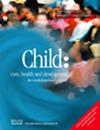Socio-Emotional Development in Young Children With Cerebral Palsy: A Scoping Review
Abstract
Background
Cerebral palsy (CP) is the most common physical disability in childhood, yet research on the socio-emotional development of young children with or at high risk of CP remains limited. The aim of the study is to describe how socio-emotional development has been investigated in young children diagnosed with or at high risk of CP and identify knowledge gaps and areas for future research.
Methods
A scoping review based on a systematic search of PsycInfo, PubMed and Web of Science including studies on children aged 0–6:11 years diagnosed with or at high risk of CP, examining socio-emotional development. No restrictions on publication year or language were applied. Data were extracted following PRISMA guidelines for scoping reviews.
Results
Twenty-five studies, representing 1914 toddlers and preschool children, were included. No studies exclusively examined infants. Most studies were cross-sectional (68%) and used parent-reported data (76%). The most commonly investigated areas of socio-emotional development were expressing negative emotionality, engagement in peer relationships and exploratory behaviour. Less optimal socio-emotional development was frequently reported, with prevalence estimates ranging from 14% to 65%. Socio-emotional difficulties were associated with severity of child motor disability, child delayed language abilities and parenting difficulties.
Conclusion
This review identifies conceptual and methodological limitations in studies of socio-emotional development in young children with CP. Future research should include infants from a diverse range of geographical and cultural contexts, utilize observational or multi-informant methods, investigate positive emotionality and parent–child relationships and adopt longitudinal designs to better capture if and how CP may impact socio-emotional development in early childhood.


 求助内容:
求助内容: 应助结果提醒方式:
应助结果提醒方式:


